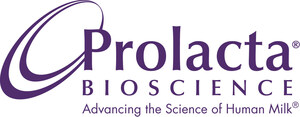New Study Exposes Bovine Fortification Protocol Is Hurdle to Advancing the Standard of Care, Questions Feasibility of Randomized Controlled Trials in Vulnerable Premature Infant Population
DUARTE, Calif., Feb. 6, 2024 /PRNewswire/ -- Optimizing nutrition for premature infants remains an important focus in neonatal care. More than 20 peer-reviewed studies of 5,000+ preterm infants demonstrated that, compared to bovine milk-based fortifiers (BMBF), Prolacta Bioscience's human milk-based fortifiers (HMBF) improve growth and development1-7 and provide clinically significant reductions in comorbidities.1,2,8-20 The health benefits from the use of HMBF have also shown significant annual cost savings for hospitals.8 More than 100,000 critically ill and preterm infants have received Prolacta's human milk-based nutritional products.21
Prolacta's Exclusive Human Milk Diet (EHMD) Protocol, introduced in 2022, is based on data showing that hospitals with the best outcomes start fortification as early as day one and advance feeds quickly.1,7,22 Yet, in contrast to this protocol and more than a decade of extensive clinical evidence, two small randomized controlled trials (RCTs) — Jensen with 228 infants and O'Connor with 127 infants — found no statistically significant difference in mortality and morbidity when comparing HMBF to BMBF. While the RCTs were intended to provide a head-to-head comparison between fortifier products, the feeding protocols fundamentally differed. HMBF recommendations for best outcomes regarding the day fortification should begin and the speed at which feeds are advanced were not followed in either study.
Both RCTs were designed more than six years ago with fortification protocols intended to mitigate the risks of BMBF, which is known to cause feeding intolerance and severe complications in preterm infants, including sepsis and necrotizing enterocolitis (NEC), a leading cause of preemie death.23
Ethical Boundaries Limit RCT Feasibility
The ability to fortify early and advance feeds quickly with HMBF raises an important ethical issue for RCT design. The known risks of BMBF established the decades-old standard of care in the neonatal intensive care unit (NICU) to delay fortification until preterm infants can tolerate the risks of the foreign protein.
- Given these known risks, randomizing extremely premature infants to day-one fortification with BMBF would unjustly endanger this vulnerable patient population.
- In seeking to mitigate BMBF's risk, the protocols used in the RCTs demonstrated severely delayed EHMD implementation, thus reducing the observable EHMD benefits.
- Yet, despite feeding protocols that were incongruent with established EHMD guidelines, both the RCTs showed lower morbidity and mortality rates for infants in the HMBF arms, which are clinically significant findings:
- While significantly underpowered, the Jensen study showed the HMBF death rate was 47% lower than BMBF.24
- After adjusting for gestational age, the HMBF group in the Jensen study had decreased odds of bronchopulmonary dysplasia (BPD) at 36 weeks (p = 0.049).24
- The O'Connor study demonstrated a 50% reduction in late-onset sepsis and a statistically significant reduction in retinopathy of prematurity (ROP) in infants receiving HMBF.13
"As clinicians, we must review studies with a critical lens and truly consider the body of evidence on topics critical to the well-being of our patients," said Melinda Elliott, MD, FAAP, practicing neonatologist and chief medical officer for Prolacta. "I am convinced about the advantages of HMBF for critically ill and premature babies because I witnessed the impact with my own patients in Baltimore. What began as an initiative to decrease the incidence of NEC in our unit quickly became a unit-wide initiative to provide a clearly superior standard of care."
Real-World Evidence Demonstrates Improved Outcomes and Reduced Costs
Extensive real-world data affirm EHMD adoption enables critical health improvements for premature infants and major cost reductions for hospitals. Analysis of 2019-2022 data from 3,000+ patients at 60+ U.S. hospitals found EHMD implementation improved health outcomes and reduced costs, generating a 2.6X dollar-for-dollar return on investment.25 Similarly, a 2023 peer-reviewed report found EHMD implementation resulted in annual cost savings of $500,000 to $3.4 million per hospital from a reduction in comorbidities and shorter lengths of stay among very low birth weight infants.8
The body of real-world evidence in support of HMBF is substantial. It has been clinically proven in more than 20 peer-reviewed clinical studies that compared to BMBF, HMBF when used as part of an Exclusive Human Milk Diet demonstrated:
- Lower mortality and morbidity14,16,19
- Reduced incidence of feeding intolerance15
- Achieved adequate growth1,2,7
- Reduced incidence of BPD1,12,14,15
- Reduced incidence of ROP12,14,15
- Reduced late-onset sepsis incidence and evaluations12-14
- Reduced risk of NEC14,15,20
- Improved long-term outcomes such as neurodevelopment4,5
- Shortened stays in the NICU15
- Reduced hospital costs8,15,25,26
- Achieved better growth in term infants recovering from surgery for single ventricle physiology (SVP)27 and congenital gastrointestinal disorders (CGIDs)28
About Prolacta Bioscience
Prolacta Bioscience® is a global life sciences company dedicated to Advancing the Science of Human Milk® to improve health outcomes for critically ill and premature infants. More than 100,00021 extremely premature infants worldwide have benefited from Prolacta's human milk-based products, which have been evaluated in more than 20 peer-reviewed clinical studies. Hospitals adopting Prolacta's Exclusive Human Milk Diet realize a 2.6X return on investment.25 Operating the world's first pharmaceutical-grade human milk processing facilities, Prolacta maintains the industry's strictest quality and safety standards, with over 20 validated tests for screening and testing human milk. Prolacta's manufacturing process uses vat pasteurization to ensure pathogen inactivation while protecting nutritional composition and bioactivity. Learn more at www.prolacta.com, on X, Instagram, Facebook, and LinkedIn.
Media Contact:
Loren Kosmont
[email protected]
310-721-9444
References
- Huston R, Lee M, Rider E, et al. Early fortification of enteral feedings for infants <1250 grams birth weight receiving a human milk diet including human milk-based fortifier. J Neonatal Perinatal Med. 2020;13(2):215-221. doi:10.3233/NPM-190300
- Huston RK, Markell AM, McCulley EA, Gardiner SK, Sweeney SL. Improving growth for infants ≤1250 grams receiving an exclusive human milk diet. Nutr Clin Pract. 2018;33(5):671-678. doi:10.1002/ncp.10054
- Gates A, Thompson AB, Marin T, Waller JL, Patel J, Stansfield BK. Novel multinutrient human milk-based human milk fortifier promotes growth and tolerance in premature infants. J Parenter Enteral Nutr. 2022;46(4):817-827. doi:10.1002/jpen.2249
- Bergner EM, Shypailo R, Visuthranukul C, et al. Growth, body composition, and neurodevelopmental outcomes at 2 years among preterm infants fed an exclusive human milk diet in the neonatal intensive care unit: a pilot study. Breastfeed Med. 2020. 15(5):304-311. doi:10.1089/bfm.2019.0210
- Rahman A, Kase J, Murray Y, et al. Neurodevelopmental outcome of extremely low birth weight infants fed an exclusive human milk diet is not affected by growth velocity. Breastfeed Med. 2020;15(6):362-369. doi:10.1089/bfm.2019.0214
- Sandhu A, Fast S, Bonnar K, Baier RJ, Narvey M. Human-based human milk fortifier as rescue therapy in very low birth weight infants demonstrating intolerance to bovine-based human milk fortifier. Breastfeed Med. 2017;12(9):570-573. doi:10.1089/bfm.2017.0017
- Hair AB, Hawthorne KM, Chetta KE, Abrams SA. Human milk feeding supports adequate growth in infants ≤ 1250 grams birth weight. BMC Res Notes. 2013;6:459. Published 2013 Nov 13. doi:10.1186/1756-0500-6-459
- Swanson JR, Becker A, Fox J, et al. Implementing an exclusive human milk diet for preterm infants: real-world experience in diverse NICUs. BMC Pediatr. 2023;23(1). doi.org/10.1186/s12887-023-04047-5
- Osmanova M, Müller MJ, Habisch B, Hippe A, Seeliger S. Nutrition of infants with very low birth weight using human and bovine based milk fortifier: benefits and costs. Neonat Pediatr Med. 2021;S10:003.
- Hanford J, Mannebach K, Ohler A, Patten M, Pardalos J. Rates of comorbidities in very low birth weight infants fed an exclusive human milk diet versus a bovine supplemented diet. Breastfeed Med. 2021;16(10):814-820. doi:10.1089/bfm.2020.0345
- Carome K, Rahman A, Parvez B. Exclusive human milk diet reduces incidence of severe intraventricular hemorrhage in extremely low birth weight infants. J Perinatol. 2021;41(3):535-543. doi:10.1038/s41372-020-00834-5
- Delaney Manthe E, Perks PH, Swanson JR. Team-based implementation of an exclusive human milk diet. Adv Neonatal Care. 2019;19(6):460-467. doi:10.1097/ANC.0000000000000676
- O'Connor DL, Kiss A, Tomlinson C, et al. Nutrient enrichment of human milk with human and bovine milk-based fortifiers for infants born weighing <1250 g: a randomized clinical trial [published correction appears in Am J Clin Nutr. 2019 Aug 1;110(2):529] [published correction appears in Am J Clin Nutr. 2020 May 1;111(5):1112]. Am J Clin Nutr. 2018;108(1):108-116. doi:10.1093/ajcn/nqy067
- Hair AB, Peluso AM, Hawthorne KM, et al. Beyond necrotizing enterocolitis prevention: improving outcomes with an exclusive human milk-based diet [published correction appears in Breastfeed Med. 2017 Dec;12 (10):663]. Breastfeed Med. 2016;11(2):70-74. doi:10.1089/bfm.2015.0134
- Assad M, Elliott MJ, Abraham JH. Decreased cost and improved feeding tolerance in VLBW infants fed an exclusive human milk diet. J Perinatol. 2016;36(3):216-220. doi:10.1038/jp.2015.168
- Abrams SA, Schanler RJ, Lee ML, Rechtman DJ. Greater mortality and morbidity in extremely preterm infants fed a diet containing cow milk protein products. Breastfeed Med. 2014;9(6):281-285. doi:10.1089/bfm.2014.0024
- Herrmann K, Carroll K. An exclusively human milk diet reduces necrotizing enterocolitis. Breastfeed Med. 2014;9(4):184-190. doi:10.1089/bfm.2013.0121
- Huston RK, Markell AM, McCulley EA, et al. Decreasing necrotizing enterocolitis and gastrointestinal bleeding in the neonatal intensive care unit: the role of donor human milk and exclusive human milk diets in infants ≤1500 g birth weight. Infant Child Adolesc Nutr. 2014;6(2):86-93. doi:10.1177/1941406413519267
- Cristofalo EA, Schanler RJ, Blanco CL, et al. Randomized trial of exclusive human milk versus preterm formula diets in extremely premature infants. J Pediatr. 2013;163(6):1592-1595.e1. doi:10.1016/j.jpeds.2013.07.011
- Sullivan S, Schanler RJ, Kim JH, et al. An exclusively human milk-based diet is associated with a lower rate of necrotizing enterocolitis than a diet of human milk and bovine milk-based products. J Pediatr. 2010;156(4):562-7.e1. doi:10.1016/j.jpeds.2009.10.040
- Data on file; estimated number of infants fed Prolacta's products from January 2007 to August 2023.
- Salas AA, Gunawan E, Nguyen K, et al. Early human milk fortification in infants born extremely preterm: a randomized trial. Pediatrics. 2023;152(3):e2023061603. doi:10.1542/peds.2023-061603
- Ginglen JG, Butki N. Necrotizing Enterocolitis. StatPearls Publishing [Internet]. 2023. Available from: https://www.ncbi.nlm.nih.gov/books/NBK513357/
- Jensen GB, Domellöf M, Ahlsson F, Elfvin A, Navér L, Abrahamsson T. Effect of human milk-based fortification in extremely preterm infants fed exclusively with breast milk: a randomised controlled trial. eClinicalMedicine. 2023. https://doi.org/10. 1016/j.eclinm.2023. 102375
- Data on file; hospital-provided outcomes analysis from 2019 to 2022.
- Ganapathy V, Hay JW, Kim JH. Costs of necrotizing enterocolitis and cost-effectiveness of exclusively human milk-based products in feeding extremely premature infants. Breastfeed Med. 2012;7(1):29-37. doi:10.1089/bfm.2011.0002
- Blanco CL, Hair A, Justice LB, Roddy D, Bonagurio K, Williams PK, Machado D, Marino BS, Chi A, Takao C, Gordon EE, Ashrafi A, Cacho N, Pruetz JD, Costello JM, Cooper DS, & Cardiac Neonate Nutrition Study Group. A randomized trial of an exclusive human milk diet in neonates with single ventricle physiology. J Pediatr. 2022;256: 105–112. doi.org/10.1016/j.jpeds.2022.11.043
- Karpen, H. Impact of an exclusive human milk diet in neonates with congenital gastrointestinal disorders: initial clinical results. Oral presentation at ISHMSI, Vienna, 2022 available at: https://player.vimeo.com/video/722923273?h=3b58d480a0
SOURCE Prolacta Bioscience

WANT YOUR COMPANY'S NEWS FEATURED ON PRNEWSWIRE.COM?
Newsrooms &
Influencers
Digital Media
Outlets
Journalists
Opted In





Share this article